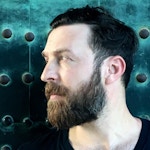Differentiated Building Skin
An Experimental Case for AM Structural Components
Sign in and Register
Create an Account
Overview
Abstract
The Los Angeles Stadium’s doubly curved skin is composed of over 35,000 unique triangular panels covering 296,502 square feet of surface area. The panels are uniquely articulated and cut to specification using a 3-axis CNC die-punch machine and fabricated from 0.125" thick anodized aluminum. The connections supporting these panels require a unique configuration for fixation at each juncture and present a foreseeable entry-point application for additively manufactured (AM) metal components.
An experimental connection prototype has been developed to address challenges unique to its differentiated geometry, fabrication process, and performance criteria. The design-to-fabrication workflow developed for the skin demonstrates improved efficacy at various stages between design development and fabrication, and is being extended for use on 3D printed metal components. Localized topology optimization yields reduced loading over commonly accepted approaches that employ standardization for a worst-case condition. In addition, the proposed node is discretized into an assembly to accommodate limited build volume commonly associated to AM systems currently on the market. The proposed approach suggests improved production time over experimental alternatives. Potential for 3D printing as a fabrication method at this scale of execution is evident. However, software developments and availability of manufacturing facilities must be realized to achieve feasibility.
Authors

James Warton
HKS Line
jwarton@hksinc.com
Keywords
Introduction
The case study presented leverages experiences and lessons learned during the design and development of a cladding system for an NFL football stadium and future home to the Los Angeles
Access Restricted
Method
Computational overhead associated to the abundance of panels and nodes existing within the stadium’s skin present significant challenges for design-to-fabrication automation. To address these challenges, a framework was developed in
Access Restricted
Data and Evaluation
While it is generally accepted that lower-level programming languages such as C++ outperform higher-level programming languages, a benchmarking trial was established to observe this in quantifiable terms. Grasshopper offers limited
Access Restricted
Conclusion
The implementation of AM building components represents a foreseeable area of innovation. This technology promises the ability to produce architectural and structural components with specificity and complexity that are restricted
Access Restricted
Acknowledgements
The research for the paper was financially supported by HKS Architects. Without the influence and encouragement of Dan Noble and Heath May this research would not have been possible. I am also grateful to the various members of the design team participating on the Los Angeles Stadium. The intelligence and collaborative spirit among this group was inspiring and provided valuable insight. Involvement on this project was essential to the foundation of this ongoing research.
Rights and Permissions
Galjaard, S., Hofman, S., Perry, N., Ren, S. “Optimizing Structural Building Elements in Metal by Using Additive Manufacturing.” Proceedings of the International Association for Shell and Spatial Structures (2015).
Galjaard, S., Hofman, S. and Ren S. “New Opportunities to Optimize Structural Designs in Metal by Using Additive Manufacturing.” Advances in Architectural Geometry. (2014): 79-93.
Levelle, E., Heijden, R., Riese, M., and Ra, N. “Data and Order, The Making of Complex Architecture.” Facade Tectonics 2016 Conference Proceedings, Vol. 2 (2016): 335-344.
Pottman, H., Eigensatz, M., Vaxman, A., and Wallner, J. “Architectural Geometry.” Computer and Graphics, Vol. 47 Issues C, Pergamon Press, Inc. Elmsford, New York, (2015): 145-164.
Sanderson C. and Curtin, R. “Armadillo: a template-based C++ library for linear algebra.” Journal of Open Source Software, Vol. 1, (2016): 26.
Warton, J., Dwivedi, R., and Kovacevic, R. “Additive Manufacturing of Metallic Alloys: An Architectural Case.” Robotic Fabrication in Architecture and Design. (2014): 147-161.
Warton, J. and Kovacevic, R. “Additive Manufacturing, Abstract Assemblage, and Material Agencies.” 2014 TxA Emerging Design + Technology Conference Proceedings. (2014): 7-17.
Yalamanchili, P., Arshad, U., Mohammed, Z., Garigipati, P., Entschev, P., Kloppenborg, B., Malcolm, J and Melonakos, J. “ArrayFire - A high performance software library for parallel computing with an easy-to-use API.” Atlanta: AccelerEyes. (2015).